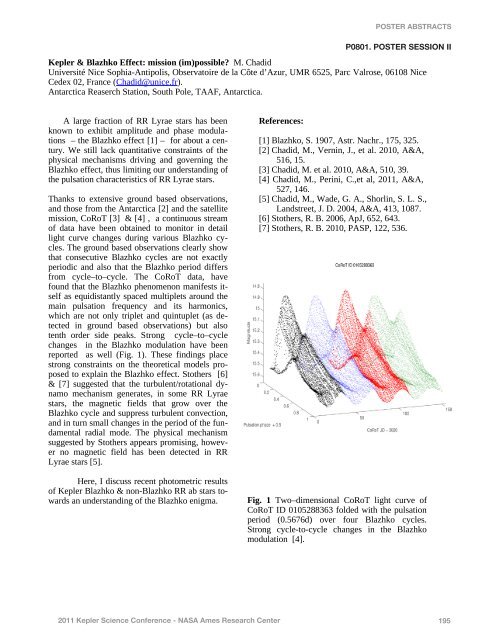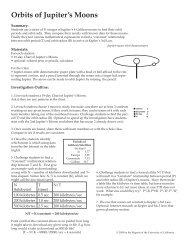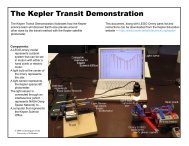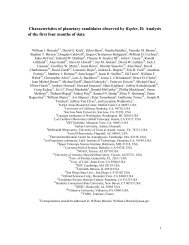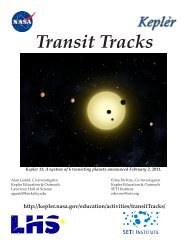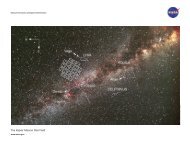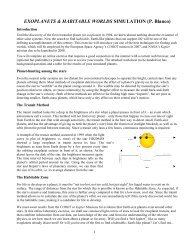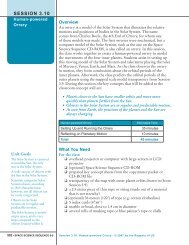Poster Abstracts - Kepler - NASA
Poster Abstracts - Kepler - NASA
Poster Abstracts - Kepler - NASA
- No tags were found...
Create successful ePaper yourself
Turn your PDF publications into a flip-book with our unique Google optimized e-Paper software.
POSTER ABSTRACTSP0801. POSTER SESSION II<strong>Kepler</strong> & Blazhko Effect: mission (im)possible? M. ChadidUniversité Nice Sophia-Antipolis, Observatoire de la Côte d’Azur, UMR 6525, Parc Valrose, 06108 NiceCedex 02, France (Chadid@unice.fr).Antarctica Reaserch Station, South Pole, TAAF, Antarctica.A large fraction of RR Lyrae stars has beenknown to exhibit amplitude and phase modulations– the Blazhko effect [1] – for about a century.We still lack quantitative constraints of thephysical mechanisms driving and governing theBlazhko effect, thus limiting our understanding ofthe pulsation characteristics of RR Lyrae stars.Thanks to extensive ground based observations,and those from the Antarctica [2] and the satellitemission, CoRoT [3] & [4] , a continuous streamof data have been obtained to monitor in detaillight curve changes during various Blazhko cycles.The ground based observations clearly showthat consecutive Blazhko cycles are not exactlyperiodic and also that the Blazhko period differsfrom cycle–to–cycle. The CoRoT data, havefound that the Blazhko phenomenon manifests itselfas equidistantly spaced multiplets around themain pulsation frequency and its harmonics,which are not only triplet and quintuplet (as detectedin ground based observations) but alsotenth order side peaks. Strong cycle–to–cyclechanges in the Blazhko modulation have beenreported as well (Fig. 1). These findings placestrong constraints on the theoretical models proposedto explain the Blazhko effect. Stothers [6]& [7] suggested that the turbulent/rotational dynamomechanism generates, in some RR Lyraestars, the magnetic fields that grow over theBlazhko cycle and suppress turbulent convection,and in turn small changes in the period of the fundamentalradial mode. The physical mechanismsuggested by Stothers appears promising, howeverno magnetic field has been detected in RRLyrae stars [5].Here, I discuss recent photometric resultsof <strong>Kepler</strong> Blazhko & non-Blazhko RR ab stars towardsan understanding of the Blazhko enigma.References:[1] Blazhko, S. 1907, Astr. Nachr., 175, 325.[2] Chadid, M., Vernin, J., et al. 2010, A&A,516, 15.[3] Chadid, M. et al. 2010, A&A, 510, 39.[4] Chadid, M., Perini, C.,et al, 2011, A&A,527, 146.[5] Chadid, M., Wade, G. A., Shorlin, S. L. S.,Landstreet, J. D. 2004, A&A, 413, 1087.[6] Stothers, R. B. 2006, ApJ, 652, 643.[7] Stothers, R. B. 2010, PASP, 122, 536.Fig. 1 Two–dimensional CoRoT light curve ofCoRoT ID 0105288363 folded with the pulsationperiod (0.5676d) over four Blazhko cycles.Strong cycle-to-cycle changes in the Blazhkomodulation [4].2011 <strong>Kepler</strong> Science Conference - <strong>NASA</strong> Ames Research Center 195


